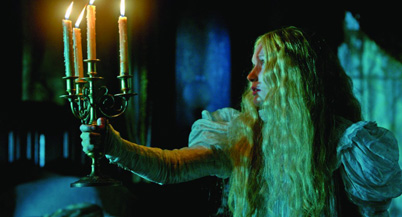The 400-Word Review: Crimson Peak
By Sean Collier
October 20, 2015
BoxOfficeProphets.com

But it is by no means a great film, either, having reached too far and retrieved too little. Clearly modeled after the likes of Jane Austen and Mary Shelley, both of whom are name-checked early in the script, Crimson Peak doesn’t have the narrative heft to support its languid pace, its somewhat-thin backstory and surprisingly hokey elements.
In other words, you should maybe see it, but you won’t have a great time.
Edith Cushing (Mia Wasikowska) is a headstrong twentysomething with ambitions of becoming a novelist. Living a privileged life in Buffalo with her wealthy father, Carter (Jim Beaver), she has difficulty getting published but few other concerns until the arrival of Sir Thomas Sharpe (Tom Hiddleston,) a dashing British inventor.
Sharpe is there looking for an investment from the elder Cushing, who sees little in the noble’s scheme. Edith, on the other hand, is immediately charmed by Sharpe, in large part due to his fascination with her writing. After Carter is brutally murdered, Edith takes solace with the visitor, eventually marrying him and crossing the Atlantic to live in his decaying manor — along with his sinister sister, Lady Lucille (Jessica Chastain).
All is clearly not right at the house, from the gaping hole in the ceiling to the blood-red clay that oozes up through the floor. Edith begins trying to unravel the mysteries of the place, but is quickly felled by an unexplained illness.
Crimson Peak grinds nearly to a halt here, as endless sequences of Edith wandering the halls linger and linger. To be fair, these are still beautiful, evocative of mid-century Italian horror and period drama simultaneously. They are just very, very slow.
Then there are the ghosts, spectral advisors that alternately terrorize and inform every 20 minutes or so. It’s baffling that del Toro, a visual maven, allowed schlocky, computer-generated ghouls to dominate his film; they look simply awful and pull the viewer out of the film in a hurry. Fine acting and beautiful sets are not enough to make me pretend an XBox monster belongs in a serious film.
My Rating: 6/10
Sean Collier is the Associate Editor of Pittsburgh Magazine and a member of the Broadcast Film Critics Association. Read more from Sean at pittsburghmagazine.com/afterdark